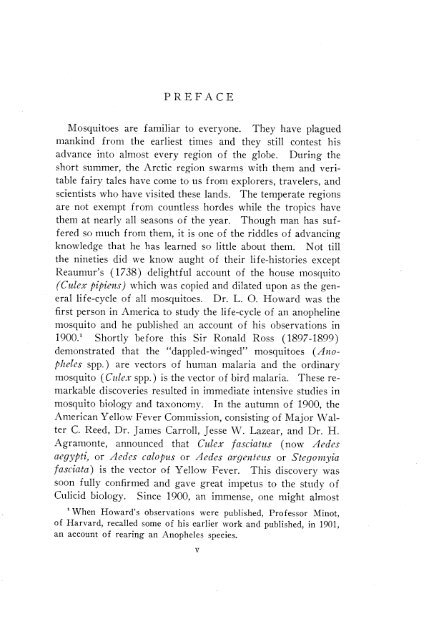a handbook of the mosquitoes of north america - Systematic Catalog ...
a handbook of the mosquitoes of north america - Systematic Catalog ...
a handbook of the mosquitoes of north america - Systematic Catalog ...
Create successful ePaper yourself
Turn your PDF publications into a flip-book with our unique Google optimized e-Paper software.
PREFACE<br />
Mosquitoes are familiar to everyone. They have plagued<br />
mankind from <strong>the</strong> earliest times and <strong>the</strong>y still contest his<br />
advance into almost every region <strong>of</strong> <strong>the</strong> globe. During <strong>the</strong><br />
short summer, <strong>the</strong> Arctic region swarms with <strong>the</strong>m and veri-<br />
table fairy tales have come to us fro,m explorers, travelers, and<br />
scientists who have visited <strong>the</strong>se lands. The temperate regions<br />
are not exempt from countless hordes while <strong>the</strong> tropics have<br />
<strong>the</strong>m at nearly all seasons <strong>of</strong> <strong>the</strong> year. Though man has suf-<br />
fered so much from <strong>the</strong>m, it is one <strong>of</strong> <strong>the</strong> riddles <strong>of</strong> advancing<br />
knowledge that he has learned so little about <strong>the</strong>m. Not till<br />
<strong>the</strong> nineties did we know aught <strong>of</strong> <strong>the</strong>ir life-histories except<br />
Reaumur’s ( 1738) delightful account <strong>of</strong> <strong>the</strong> house mosquito<br />
(C&x pipiem) which was copied and dilated upon as <strong>the</strong> gen-<br />
eral life-cycle <strong>of</strong> all <strong>mosquitoes</strong>. Dr. L. 0. Howard was <strong>the</strong><br />
first person in America to study <strong>the</strong> life-cycle <strong>of</strong> an anopheline<br />
mosquito and he published an account <strong>of</strong> his observations in<br />
1900.’ Shortly before this Sir Ronald Ross (1897-1899)<br />
demonstrated that <strong>the</strong> “dappled-winged” <strong>mosquitoes</strong> (Ano-<br />
p/&es spp. ) are vectors <strong>of</strong> human malaria and <strong>the</strong> ordinary<br />
mosquito (Cz~lex spp. ) is <strong>the</strong> vector <strong>of</strong> ibird malaria. These re-<br />
markable discoveries resulted in immediate intensive studies in<br />
mosquito biology and taxonomy. In <strong>the</strong> autumn <strong>of</strong> 1900, <strong>the</strong><br />
American Yellow Fever Commission, consisting <strong>of</strong> Major Wal-<br />
ter C. Reed, Dr. James Carroll, Jesse W. Lazear, and Dr. H.<br />
Agramonte, announced that Culex fasciatzu (now Aedes<br />
aegypti, or Aedes calopus or Aedes argezteus or Stegonzyia<br />
fasciata) is <strong>the</strong> vector <strong>of</strong> Yellow Fever. This discovery was<br />
soon fully confirmed and gave great impetus to <strong>the</strong> study <strong>of</strong><br />
Culicid biology. Since 1900, an immense, one might almost<br />
’ When Howard’s observations were published, Pr<strong>of</strong>essor Minot,<br />
<strong>of</strong> Harvard, recalled some <strong>of</strong> his earlier work and published, in 1901,<br />
an account <strong>of</strong> rearing an Anopheles species.

















